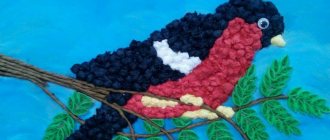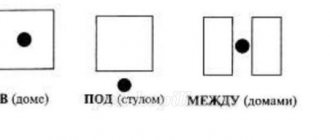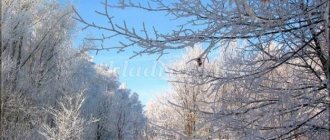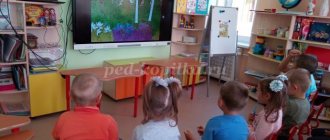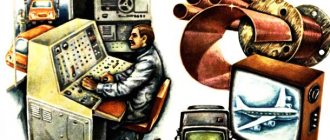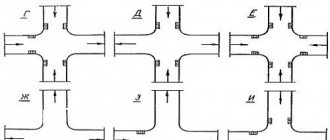Goal: familiarization with the mnemonic method.
Tasks:
Educational:
- introduce mnemonics as an element of mnemonics;
- practice composing sentences of 3-5 words based on symbols.
Educational:
- develop imagination and creative activity;
- form associative thinking;
- develop mental operations of analysis and synthesis;
- improve visual perception and attention.
Educational:
- cultivate a desire to communicate and make friends with peers.
Materials and equipment : module or chairs for simulating a ship, a pointer, a bottle with a letter, a mnemonic track, mnemonic squares, balloons, Hawaiians (flower beads), an audio recording with the song “Chunga-Changa” and the sounds of the river.
PROGRESS OF THE CLASS
1.Organizational moment
Educator: Guys, what time of year is it now?
Children: Summer
Educator: What's the weather like today?
Children: Hot, warm, sunny, etc.
Educator: In such hot weather, it’s nice to spend time on the river, and I invite you to a river boat trip. Go on deck.
Children, to the sound of the surf, walk along a ribbed board “ladder” and sit on an improvised deck.
2. Introduction to the topic
Educator: Breathe in the cool river air. Look at the blue surface of the river, listen to the waves splashing. Look, there’s something floating in the distance (the teacher pulls out a bottle covered with algae and shells by the rope) Let’s see what’s inside (pulls out a letter)
3. Consideration of the mnemonic table
Educator: What do you think this is? (pulls out a scroll and unfolds it) Children: message, map, etc.
Educator: Maybe this is a letter? But it is unusual, it consists of pictures. Let's try to decipher the pictures and read the letter.
Educator: Look at the first symbol picture. Who do you think sent us the letter?
Children: These are children: a boy and a girl.
Educator: What do they want to tell us about themselves? Look at the pictures one by one.
With the help of the teacher's leading questions, children compose a story using reference pictures.
Children: They live on a desert island. They have warm weather, it’s hot, the sun is shining brightly. Crabs, fish and turtles live on the island, and various fruits grow: pineapples, bananas. Children on the island love to play ball, badminton and swim in the sea.
Educator: Look how the children finished their message. What are they telling us? What do they usually write at the end of a letter?
Children: Let's be friends! Write us a reply. Goodbye!
4. Physical education break
Educator: It seems to me that I know these guys. They are from the island of Chunga Changa. Would you like to dance their favorite dance? Here are the islanders' jewelry (children wear flower beads and Hawaiian shirts around their necks). Come out onto the deck.
These signal cards will help us learn a cheerful dance (the teacher shows the card and explains the movement).
| circular movements with hands, “motor” |
| raise your arms up to the right, then to the left |
| step left and right, arms raised up at right angles |
Let's first perform these movements without music, and now with music. Be very careful, watch the symbols change.
The teacher randomly shows symbol cards, and the children perform a dance movement in accordance with it. At the last chorus, the symbols are removed and the children dance in free form.
4. Work on drawing up proposals.
Educator: Well, I think the kids from the island of Chunga-Changa will really like the way we dance.
But they invited us to be friends, and are waiting for an answer. Are you ready to write them a letter?
Children: Yes
Educator: To do this, break into pairs and think together about what you would like to tell your new friends? Choose a picture that will help tell the story.
Children, working in pairs, choose any symbol picture on the table and use it to make a sentence.
Educator: Let's start our letter. I propose to do this the same way as our friends (attaches a picture of a boy and a girl on the board). What did we say?
Children: Hello, we are children too - boys and girls.
Educator: Now continue, what else can you tell our new friends.
(Children say their sentences based on symbols. The teacher lays them out on the board: We live in the city. We love to play sports, ride a bike downhill, draw. We have pets: cats, dogs, birds, etc. )
Educator: How will we end our letter-message? How do we say goodbye, what symbols and pictures will we use to indicate this?
Children: Let's be friends! Waiting for an answer. Goodbye!
The teacher adds an image of an envelope and a hand.
5.End of class
Educator: Our letter is ready, now it can be sent, but how to do it?
Children: On a plane, throw it in a bottle and send it down the river, etc.
Educator: All the proposed options are wonderful, but I want to suggest this method .
I have wonderful friends
Light, nimble, useful.
We will tie the letter to them,
We will show them the right path.
(Children tie the letter to balloons and release it into the sky)
Fly into the sky, balls,
Bring the news to your friends!
6. Summing up
Educator: I hope that new friends will receive the letter and will definitely answer or come to visit, but our walk has come to an end, it’s time to return to the shore.
Did you enjoy our trip? What do you remember most? What new things have you learned? What did you find difficult?
As a souvenir of our walk, I want to give you unusual beads made of flowers, so that you can tell about your new friends at home and teach the dance from the island of Chunga-Changa to your parents and friends.
Notes on educational activities for speech development, lesson plan for speech development
Summary of educational activities for speech development in the preparatory group “Composing a story based on a series of plot paintings”
Goal: To teach a coherent, sequential presentation of events in a series of plot paintings. Objectives: Educational: To teach how to convey the plot embedded in a series of paintings. Developmental: To develop the ability to independently invent events. Educational: To cultivate respect for the work of others Preliminary work: Game “what happened first, what Then?"; Reading stories about the seasons. Equipment: a series of story pictures (in an envelope), a ball. GCD move: 1. Organizational moment. Educator: Guys, this morning the postman brought a letter to our kindergarten. Invites reading children to read who it is addressed to. They discover that they are in our group. Educator: Let's see what's in it! (A letter from Chanterelle, in which she writes that she wants to take part in a short story competition. But she needs help to compose the best story. There are still pictures in the envelope). Educator: Do you agree to help Chanterelle? What needs to be done for this? Children's answers: Arrange the pictures in order, look at each picture, make up several sentences for each picture, come up with a name, make up a story based on all the pictures. Educator: In order for our story to work out, let's play and remember the signs of winter. Game exercise “Complete the sentence” (with a ball): In autumn there is leaf fall, and in winter (snowfall). In summer there is rain, and in winter (snow). In spring the snow melts, and in winter it (falls). In the summer they ride a bicycle, and in the winter they ride a sled. In spring everything wakes up, and in winter everything (sleeps). It's hot in summer and cold in winter. In autumn the leaves are yellow, and in winter they are white. Plants grow in summer, and snowdrifts grow in winter. In the spring, insects come out, and in the winter they hide. In the spring the bear wakes up, and in the winter (sleeps). In summer the days are long, and in winter they are short. In summer the wind is warm, and in winter (cold). In summer the hare is gray, and in winter (white).
2. Main stage Children sit on chairs near the magnetic board. The teacher puts the pictures on the magnetic board out of order (one picture is not according to the plot). Educator: Look carefully at the pictures. What do these pictures have in common? Children: All the pictures have the same characters. Educator: Which picture do you think should be first? Why? What is the second, third, fourth, fifth? Children's answers. Children arrange the pictures in the correct order one by one. Conversation on the pictures: Educator: What time of year is shown in the first picture? Children: Winter Educator: What are the children doing? Children's answers. Educator: Look at the second picture. - What has changed in the picture? - What did the hare plan to do? - How did he decide to do it? Children's answers. Educator: Look at the third picture. - What did the hare come up with after unsuccessful jump for the carrot? - Was the hare able to reach the carrot? Why? Children's answers. Educator: Look at the fourth picture. - What mood is the hare in? Why? - What do you think the hare will do next? Educator: Look at the fifth picture. - What happened to the snowman? - Why did he melt? - What is the hare’s mood? Why?
3. Physical education Children began to ski (hold your palms horizontally in front of your chest and make movements back and forth, as if skiing),
And somersault in the snow (make synchronized circular movements with your hands in front of your chest: with your right hand clockwise, and with your left hand counterclockwise).
Wanted to play snowballs (transfer the “snowball” from one palm to another)
They began to sculpt them and throw them at each other - (“make” a snowball, and then pretend to “throw” it at someone).
The snowballs began to roll (imitate the corresponding movements)
- sculpt a snow woman (from the bottom up, with both hands, simultaneously draw three snowballs standing on top of each other: large, medium and small) Fun in winter! I don’t want to go home! Educator: Now let’s play the game “Continue the Story.” Next, the children compose and tell a story based on a series of pictures, and compose a continuation for it. The teacher writes down the stories, then puts them in an envelope. Educator: Guys, I think that Chanterelle will really like the story we have compiled and she will be able to win the competition. And we will play a little more. The game “Living Words”. (One of the children becomes a word - children, this word itself does not tell us or tell us anything, and we do not know anything about children: what they are like, what they do. What do you think needs to be done so that the words begin to tell them? you need to make friends and stand in a certain order. (Children are selected who become the words “friendly”, “children”, “made”, “big”, “snowman”). Task: stand in the right order - “Friendly children built a big snowman” . So we have a sentence. Let's read it. (First, the “word children” repeat their words, and then one of the “spectator children.” Tell me, what did you learn about children from this sentence? Educator: I have something for you Another game! Let’s select words with the same root for the word “snow.” (Children speak one by one, whoever doesn’t name it drops out of the game, the winner receives a medal.) Children’s answers.
4. Reflection: - What did we talk about in class today? Who did you receive the letter from? What did Chanterelle ask us for? Who was the story about? What was your favorite thing to do?
